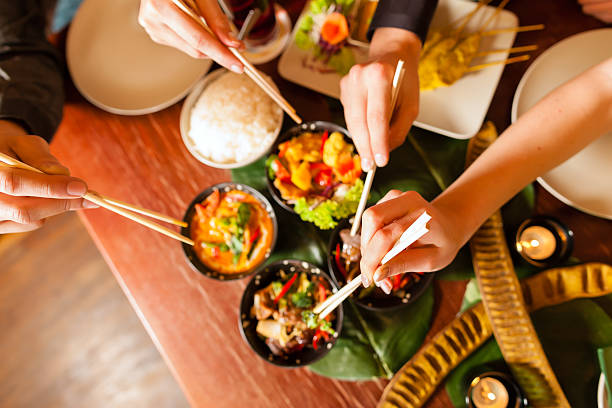Chinese cuisine, with its unparalleled richness and diversity, is one of the oldest and most sophisticated culinary traditions in the world, with a history spanning thousands of years.[1, 2, 3] It is not merely a means to satisfy hunger, but an integral part of Chinese culture, deeply rooted in traditions, festivals, and ancient philosophies.[1] Chinese dishes have greatly influenced many other cuisines throughout Asia and beyond, inspiring dining practices and tools such as chopsticks and the use of woks.
Historical Roots and Culinary Philosophy
The culinary history of China dates back more than 5,000 years, with evidence of Homo erectus using fire for cooking (roasting meat) as early as 500,000 years ago. Rice cultivation began around 8000 BCE in the Hunan region, while millet appeared in northern China around 7000 BCE. Pigs were domesticated around 6000 BCE, and wheat and barley were introduced from the Middle East between 3000-2000 BCE. China is also the world’s oldest wine-producing region, with rice, honey, and fruit wines dating to about 7000 BCE. Between 1050–256 BCE, soybeans were cultivated, and soy milk and tofu processing developed between 25–220 CE. The completion of the Grand Canal in 605 CE facilitated mass food shipping from the south to the north. Later periods saw the gradual introduction of New World foods such as sweet potatoes, corn, potatoes, peanuts, chili peppers, and tomatoes, starting around 1514 CE.
Chinese culinary philosophy is based on principles derived from traditional Chinese medicine and the yin-yang theory, aiming to achieve harmony between body and mind. Unlike many Western cuisines that highlight a single ingredient, Chinese food is collective, multi-layered, and multi-dimensional, built on balance and contrast, function and pleasure, season and region, and the belief that food is a form of healing.
Yin and Yang: This ancient concept represents the balance of opposing yet complementary forces. In food, yin is manifested in cooling foods (e.g., cucumber, tofu, green beans, leafy vegetables), while yang represents warming and stimulating foods (e.g., ginger, garlic, lamb, chili peppers). A balanced Chinese meal includes both, considering the season, weather, and even the individual’s nature.
The Five Flavors (五味): The five key flavors (sweet, sour, bitter, salty, spicy) are another foundational concept. According to traditional Chinese medicine, these correspond to different organs and bodily functions: sweet nourishes the spleen and stomach, sour supports the liver, bitter removes heat and benefits the heart, salty nourishes the kidneys, and spicy enhances circulation and benefits the lungs.
Harmony and Balance: Chinese chefs strive for variety in flavors, textures, and colors within a dish to achieve harmony and balance. Fresh, seasonal ingredients are preferred. Meals are not structured around a central dish and sides but are built around complementary contrasts: protein vs. vegetables, dry vs. saucy, mild vs. spicy, warm vs. cool. Meals often include a light soup at the beginning or end, multiple shared dishes with varied flavors and textures, and rice or noodles as a neutral base.
The Eight Great Chinese Cuisines: A Regional Tasting Journey
Chinese cuisine is divided into eight major schools, known as the “Eight Great Cuisines of China,” each reflecting the geographical, climatic, and cultural diversity of the country and offering unique flavors, ingredients, and cooking methods.[4, 5, 6, 7] These culinary styles were not definitively classified until the end of the Qing Dynasty (1636–1912).
Sichuan Cuisine (川菜): Known for bold, spicy flavors and its distinctive “mala” (麻辣) sensation—a combination of chili heat and the numbing effect of Sichuan peppercorns. Commonly uses garlic, ginger, and peanuts. Signature dishes: Mapo Tofu, Kung Pao Chicken, Hot Pot. It features seven base flavors and over 24 compound flavors, with more than 3000 traditional dishes and 24 popular cooking methods.
Cantonese Cuisine (粤菜): Emphasizes fresh ingredients, light preparation, delicate techniques, and mild, umami-rich, slightly sweet flavors. Famous for seafood and rice dishes. Signature dishes: Dim Sum (e.g., shrimp dumplings, BBQ pork rolls), Char Siu (roast pork), steamed fish with ginger and scallions. Widely uses edible offal, chicken feet, duck tongues, preserved and fermented items such as pickled cabbage, fermented tofu, and salted duck.
Shandong Cuisine (鲁菜): One of the oldest culinary traditions, known for fresh seafood, salty umami flavors, and complex techniques. It is the imperial court cuisine. Signature dishes: Peking Duck (originating from Shandong), braised sea cucumber with scallions, sweet and sour carp. Emphasizes the original flavor of ingredients, and frequently uses scallions, ginger, and garlic. “Bao” (high-heat stir-frying) is a key technique.
Hunan Cuisine (湘菜): Extremely spicy and sour, using chili peppers, garlic, and scallions abundantly. It is “dry and spicy” (gan la), unlike the numbing spiciness of Sichuan cuisine. Signature dishes: steamed fish head with chopped chili, stir-fried pork with chili, stinky tofu of Changsha. Slow cooking (stewing) is a prominent skill here.
Fujian Cuisine (闽菜): Known for light, pure flavors with a focus on seafood and soups. Uses ingredients from both sea and mountains, combining mild sweetness and sourness. Signature dishes: Buddha Jumps Over the Wall, oyster omelet, red wine chicken. Highlights knife skills and the use of broths and soups.
Zhejiang Cuisine (浙菜): Features fresh, soft, light flavors, focusing on seasonal ingredients, seafood, and freshwater fish. Signature dishes: West Lake fish in vinegar sauce, Longjing tea shrimp, Dongpo pork. Preserves the original flavor of ingredients.
Jiangsu Cuisine (苏菜): Famous for delicate flavors, elegant presentation, precise techniques, and a focus on soups and seafood. Often served at government banquets. Signature dishes: salted Nanjing duck, sweet and sour mandarin fish, Beggar’s chicken. Known for artistic cutting skills—chefs can slice tofu into 30 thin sheets.
Anhui Cuisine (徽菜): Uses many wild plants and animals, prefers slow cooking (simmering and steaming), and offers rustic flavors. Signature dishes: stinky mandarin fish, fried hair tofu, stewed Huangshan pigeon. Frequently uses local rapeseed oil and cured pork as a distinctive seasoning.
Key Ingredients and Cooking Techniques
Chinese dishes rely on a wide range of fresh, seasonal ingredients, along with preserved foods such as pickled vegetables, salted fish, and cured meats. Key ingredients include rice, noodles, scallions, garlic, shiitake mushrooms, sesame oil, ginger, soy sauce (light and dark), Shaoxing wine, rice vinegar, and chili bean paste. Cornstarch is commonly used to thicken sauces and soups.
Chinese cooking techniques are diverse and sophisticated, aiming to enhance the natural flavors of ingredients.[2, 8] Major techniques include:
Stir-Frying (炒): The most common method, cooking bite-sized ingredients quickly over high heat.
Deep-Frying (炸): Produces crispy textures by submerging ingredients in hot oil.
Braising/Stewing (燜, 炆): Slowly cooking large ingredients until tender, often with broth and spices.
Steaming (蒸): A healthy method that preserves natural flavors, used for steamed buns and dumplings.
Boiling (煮): Cooking small, soft ingredients in boiling water, especially for soups and vegetables.
Roasting (烤): Cooking over open flame or in an oven, creating a dry, roasted surface with retained flavors.
High-Heat Stir-Frying (Bao / 爆): Quick-cooking small quantities over very high heat to seal in juices.
Shallow-Frying (煎): Using minimal oil to fry ingredients to a golden brown.
Simmering in Broth (Wui / 燴): Slowly cooking ingredients in broth, often thickened with starch.
Conclusion
Chinese cuisine is a profound sensory and cultural experience that transcends mere eating—it embodies a philosophy of life and harmony. With its long history, regional diversity, and balanced culinary principles, Chinese cuisine continues to captivate the world, offering visitors an unforgettable journey through flavors and traditions that have shaped a great civilization. Every dish tells a story, every meal fosters social bonds, making food in China not just sustenance, but a living art form that evolves while preserving its ancient roots.








